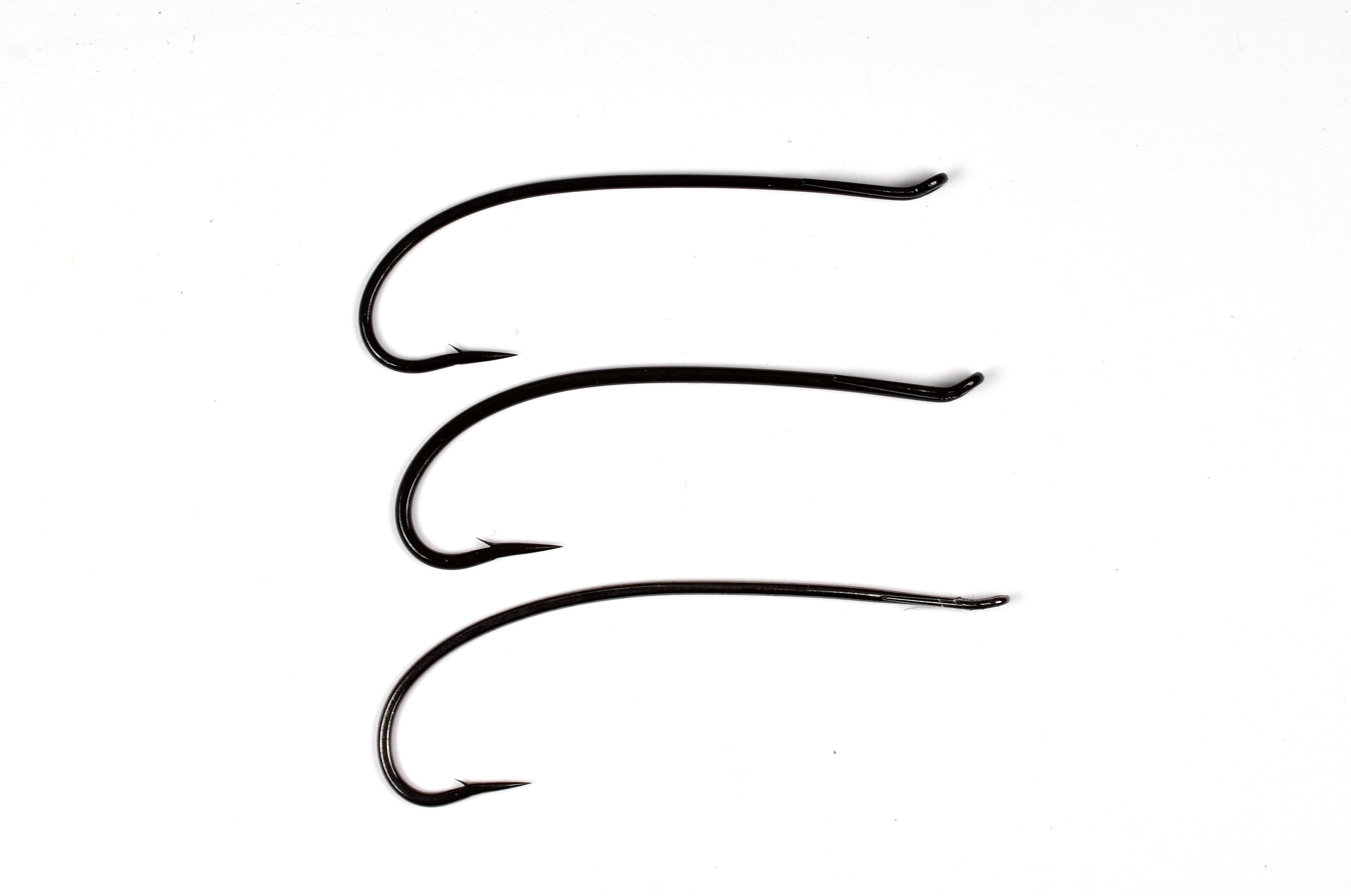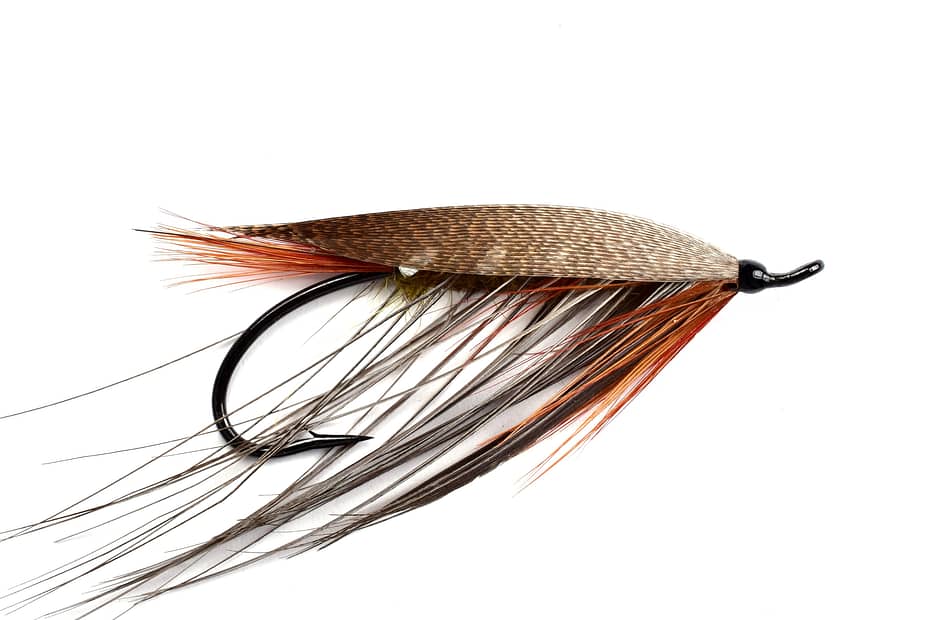How Tie A Perfect Spey Fly – Part 3
In this blog, Perfect Spey Fly?, I discuss the hooks, materials and techniques I use to tie Spey flies. Original Scottish Spey flies were simple constructions. Furthermore, they often omitted a tail (the one exception was the Lady Caroline above). The body of Spey flies was constructed of wool with a Spey cock or heron feather wrapped as a body hackle. In addition, several tinsel wraps were added. Finally, a teal or guinea feather was wound as a throat hackle (again the exception was the Lady Caroline that called for a golden pheasant breast feather). After that, the wings were simple paired slips of bronze mallard flank feathers.

and Blue Heron Spey hook (bottom)
Hooks
Traditional black up turned loop eye Atlantic salmon are most often used for tying Spey flies. Furthermore, original Scottish Spey flies were tied on long shank blind eye Atlantic salmon hooks. Similar hooks are still manufactured but require the addition of a loop of silk or braided monofilament at the front.
However, today’s fly tiers can take advantage of modern upturned eye Atlantic salmon hooks. The Daiichi Alex Jackson model 2051 hook and heavier model 2061 (shown above) are an excellent choice. Both feather a graceful bend and sharp point. This style hook is available in black, blue, silver and gold finishes. Another excellent hook for tying Spey flies is the Blue Heron Spey hooks (bottom hook shown above). This hook was designed by Dave McNeese and manufactured by Gamakatsu of Japan. These hooks feature a 3X long shank, low set eye, extremely sharp points and a hard black chrome finish.

Body Material
Early Scottish Spey flies were tied with a body of Berlin or pig’s wool. Unfortunately, pig’s wool is expensive and only available from distributors of special fly tying materials. Berlin wool came from Merino sheep. Fortunately, it is still readily available today as skeins of yarn at sewing supply retailers. Check the package to make sure it is Merino wool. The yarn can be used as is as a body wrap. In addition, the yarn can be cut into ½ to ¾ inch long strips and blended in a coffee bean grinder to make dubbing. Several colors of yarn can be mixed. For example, brown and olive blended together produces dubbing for the Lady Caroline pattern as shown above.
Tinsel Wrap
Several tinsel wraps over the wool body are customary when tying Spey flies. Today, mylar tinsel is readily available and comes in both flat and oval and different sizes. A fairly wide flat tinsel, most often silver, was the main body wrap for early Spey flies. In addition, one or more wraps of small silver or gold tinsel were also used. Moreover, sometimes the last oval tinsel wrap was wrapped counter to the body hackle to help prevent it from breaking.

Body Hackle
One unique feature of Spey flies is the body hackle. Body hackles on early flies were from the Spey cock, a type of rooster chicken, or heron, likely the European Grey Heron Ardea cinerea. Today, North American herons are protected and it is illegal to possess the feathers. Blue eared pheasant is often suggested as a substitute but the feather is usually not long enough to palmer the entire body.
The original Spey cock feather was taken from the sides of the chicken’s tail. The feather ranged in color from brown, grey and black. Although the Spey cock is thought to have disappeared many years ago, selected Schlappen feathers appear to be very similar. These can be used as a substitute for Spey cock. Schlappen is readily available from most fly shops and comes in a variety of dyed colors as shown above.

Throat Hackle
A natural teal or guinea hen feather was most often used as a throat hackle on early Spey Scottish Spey flies. However, the Lady Caroline pattern was an exception and used a red golden pheasant breast feather. Interestingly, some of the earliest fly descriptions did not include the throat hackle. The throat hackle is wound in front of the wool body and body hackle. Natural and dyed teal hackle is readily available at fly shops.

Wing
Wings for early Spey flies were constructed of paired slips of bronzed mallard duck flank feathers. A narrow slip from both a left and right feather was used for the wing. Bronze mallard flank feathers are usually sold in packages that contain both left and right feathers.
Construction Techniques
The body wrap, tinsels and body hackle are tied in at the rear of the hook just above the hook point. Materials should be secured with thread in the reverse order they are to be wrapped forward. For example, the first material tied in is the small oval tinsel since it will be the last wrapped. The body on early Spey flies was usually thin. Moreover, an easy method to create a thin body is to twist the dubbing around the tying thread. A dubbing loop is created and twisted to form a small rope. As an alternative, a single strand of wool yarn can also be used.
After the body is wrapped, the wide flat tinsel is wrapped forward towards the hook eye. Usually, 5 turns of tinsel duplicate early Spey flies. The third turn of tinsel should be in the middle of the body. The small oval tinsel is wrapped forward spaced on or between the flat tinsel. If a second oval tinsel is not used, the body hackle should be wrapped forward before the oval tinsel. The body hackle is palmered forward to the hook eye.
history tidbit…
In the Middle Ages, a palmer was a Christian pilgrim, normally from Western Europe, who had visited the holy places in Palestine. As a token of their visits to the Holy Land, individuals brought back a palm leaf or a palm leaf folded into a cross. A hairy caterpillar known to travel long distances like the pilgrims was called a palmerworm. Subsequently, the word palmer was used to describe the technique of winding a hackle around the fly body, replicating the hairy caterpillar look. It is also desirable to counter wrap the small oval tinsel to ensure the body hackle does not break.
Some tiers like to remove the fibers from one side of the body hackle. This helps reduce bulk. The schlappen feather should be tied in at the butt, not the tip. If using a blue eared pheasant feather, it may be necessary to tie in the feather near the center of the body. This will ensure several wraps of hackle over the front of the body using the shorter feather.
care should be taken
The body of the Spey fly is completed with one or two turns of the teal or guinea hen feather tied in at the front of the fly. Of course care should be taken to ensure adequate distance remains to tie in the wings.
Slips of bronzed mallard flank feather are taken from a left and right feather for the wing. I like to strip the unused side and lower portions of a feather from the stem. Also this allows me to cut slips of equal width from the right and left feathers. The fibers are left attached to the stem. In addition, slips should include the lower grey portion of the feather. Above all this allows the fibers to stay together and not split apart.
In Conclusion
Through history, several methods for mounting the wings have been recommended. My method is simple. I mount the flank feather slips one at a time. The far side slip is mounted first. Also, spinning the thread counter clockwise before wrapping over helps ensure the thread loops over the slip. The feather slip is held in place and secured to the hook using a soft loop technique. The thread is pulled evenly and smoothly to ensure individual fibers of the feather do not split. With a little practice this technique becomes easy. The near side feather slip is mounted in a similar manner. The goal is to mount the wing in a tented fashion to look like the bottom of an upside down sail boat.
In conclusion, the head is finished with the several wraps and a whip finish of tying thread. Heads are meant to be small and neat. Moreover, several coats of head cement are applied to finish the fly.
Check out the Spey Fly collection in the Assorted Fly box collections. For further examples of modern Spey flies or to purchase!
For further information click on the blogs below:
Greatest Spey Flies Ever Tied – Discover Early History Here – Part 1
Unique Things You Need to Know-Historical Spey Fly Construction – Part 2

Great description. I’m still trying to perfect the Lady Caroline. Only issue is the wing, I think my mallard slips are too wide.
Thanks. Great info